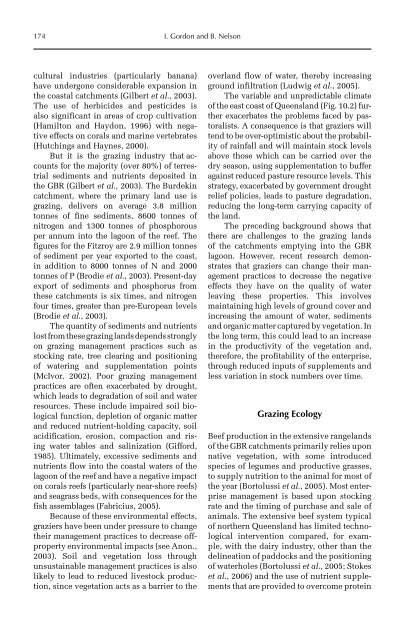Redesigning Animal Agriculture
Redesigning Animal Agriculture
Redesigning Animal Agriculture
Create successful ePaper yourself
Turn your PDF publications into a flip-book with our unique Google optimized e-Paper software.
174 I. Gordon and B. Nelson<br />
cultural industries (particularly banana)<br />
have undergone considerable expansion in<br />
the coastal catchments (Gilbert et al., 2003).<br />
The use of herbicides and pesticides is<br />
also significant in areas of crop cultivation<br />
(Hamilton and Haydon, 1996) with negative<br />
effects on corals and marine vertebrates<br />
(Hutchings and Haynes, 2000).<br />
But it is the grazing industry that accounts<br />
for the majority (over 80%) of terrestrial<br />
sediments and nutrients deposited in<br />
the GBR (Gilbert et al., 2003). The Burdekin<br />
catchment, where the primary land use is<br />
grazing, delivers on average 3.8 million<br />
tonnes of fine sediments, 8600 tonnes of<br />
nitrogen and 1300 tonnes of phosphorous<br />
per annum into the lagoon of the reef. The<br />
figures for the Fitzroy are 2.9 million tonnes<br />
of sediment per year exported to the coast,<br />
in addition to 8000 tonnes of N and 2000<br />
tonnes of P (Brodie et al., 2003). Present-day<br />
export of sediments and phosphorus from<br />
these catchments is six times, and nitrogen<br />
four times, greater than pre-European levels<br />
(Brodie et al., 2003).<br />
The quantity of sediments and nutrients<br />
lost from these grazing lands depends strongly<br />
on grazing management practices such as<br />
stocking rate, tree clearing and positioning<br />
of watering and supplementation points<br />
(McIvor, 2002). Poor grazing management<br />
practices are often exacerbated by drought,<br />
which leads to degradation of soil and water<br />
resources. These include impaired soil biological<br />
function, depletion of organic matter<br />
and reduced nutrient-holding capacity, soil<br />
acidification, erosion, compaction and rising<br />
water tables and salinization (Gifford,<br />
1985). Ultimately, excessive sediments and<br />
nutrients flow into the coastal waters of the<br />
lagoon of the reef and have a negative impact<br />
on corals reefs (particularly near-shore reefs)<br />
and seagrass beds, with consequences for the<br />
fish assemblages (Fabricius, 2005).<br />
Because of these environmental effects,<br />
graziers have been under pressure to change<br />
their management practices to decrease offproperty<br />
environmental impacts (see Anon.,<br />
2003). Soil and vegetation loss through<br />
unsustainable management practices is also<br />
likely to lead to reduced livestock production,<br />
since vegetation acts as a barrier to the<br />
overland flow of water, thereby increasing<br />
ground infiltration (Ludwig et al., 2005).<br />
The variable and unpredictable climate<br />
of the east coast of Queensland (Fig. 10.2) further<br />
exacerbates the problems faced by pastoralists.<br />
A consequence is that graziers will<br />
tend to be over-optimistic about the probability<br />
of rainfall and will maintain stock levels<br />
above those which can be carried over the<br />
dry season, using supplementation to buffer<br />
against reduced pasture resource levels. This<br />
strategy, exacerbated by government drought<br />
relief policies, leads to pasture degradation,<br />
reducing the long-term carrying capacity of<br />
the land.<br />
The preceding background shows that<br />
there are challenges to the grazing lands<br />
of the catchments emptying into the GBR<br />
lagoon. However, recent research demonstrates<br />
that graziers can change their management<br />
practices to decrease the negative<br />
effects they have on the quality of water<br />
leaving these properties. This involves<br />
maintaining high levels of ground cover and<br />
increasing the amount of water, sediments<br />
and organic matter captured by vegetation. In<br />
the long term, this could lead to an increase<br />
in the productivity of the vegetation and,<br />
therefore, the profitability of the enterprise,<br />
through reduced inputs of supplements and<br />
less variation in stock numbers over time.<br />
Grazing Ecology<br />
Beef production in the extensive rangelands<br />
of the GBR catchments primarily relies upon<br />
native vegetation, with some introduced<br />
species of legumes and productive grasses,<br />
to supply nutrition to the animal for most of<br />
the year (Bortolussi et al., 2005). Most enterprise<br />
management is based upon stocking<br />
rate and the timing of purchase and sale of<br />
animals. The extensive beef system typical<br />
of northern Queensland has limited technological<br />
intervention compared, for example,<br />
with the dairy industry, other than the<br />
delineation of paddocks and the positioning<br />
of waterholes (Bortolussi et al., 2005; Stokes<br />
et al., 2006) and the use of nutrient supplements<br />
that are provided to overcome protein










